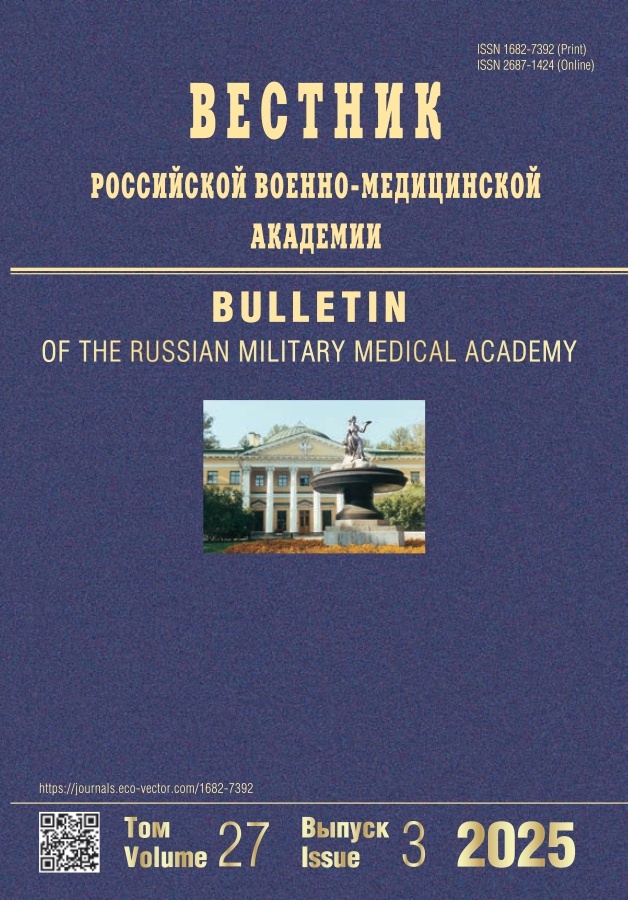About the effectiveness of cell technologies in extensive soft tissue defects plasty
- Authors: Fistal E.Y.1, Popandopulo A.G.1, Soloshenko V.V.1, Movchan K.N.2,3, Romanenkov N.S.2,3, Yakovenko O.I.2,3, Gedgafov R.M.2,3
-
Affiliations:
- V.K.Gusak Institute of Urgent and Recovery Surgery
- North-Western State Medical University named after I.I. Mechnikov
- *
- Issue: Vol 22, No 3 (2020)
- Pages: 88-92
- Section: Clinical trials
- URL: https://journals.rcsi.science/1682-7392/article/view/50540
- DOI: https://doi.org/10.17816/brmma50540
- ID: 50540
Cite item
Abstract
Abstract. Fetal fibroblast culture transplantation results were evaluated in the treatment of 18 burn victims. Comparison group consisted of 18 burn patients received medical care without cellular technologies utilization. The main comparison parameters in the study groups: the timing of the first stage of autodermoplasty; the number of autodermoplasties during the treatment; hospitalization duration; the newly formed epidermis area estimation. Fetal fibroblast culture transplantation in burn patients with extensive skin defects was performed on average 14,88±3,56 days after the injury. The timing of the first stage of autodermoplasty did not differ in the main and control groups, not exceeding an average of 19,12±2,01 days (p=0,48). An average of 2,71±0,67 surgeries using cell technologies performed in patients of the study group. The use of fetal fibroblasts culture in patients with extensive skin defects reduces the need for autodermoplasty by 1,6 times due to the granulation tissue formation and the epidermal growth beginning 7 days after and complete epidermal formation 14 days after transplantation. Regenerative medicine technologies utilization in patients with extensive skin lesions is possible and appropriate. Due to the fetal fibroblasts culture transplantation a kind of temporary biological coating is formed in the wound. It accelerates the wound healing process phase change from exudation to proliferation and the preparation of skin defects for autodermoplasty, expanding the possibilities of effective patients treatment.
Full Text
##article.viewOnOriginalSite##About the authors
E. Ya. Fistal
V.K.Gusak Institute of Urgent and Recovery Surgery
Email: nickrom@inbox.ru
Russian Federation, Donetsk
A. G. Popandopulo
V.K.Gusak Institute of Urgent and Recovery Surgery
Email: nickrom@inbox.ru
Russian Federation, Donetsk
V. V. Soloshenko
V.K.Gusak Institute of Urgent and Recovery Surgery
Email: nickrom@inbox.ru
Russian Federation, Donetsk
K. N. Movchan
North-Western State Medical University named after I.I. Mechnikov; *
Email: nickrom@inbox.ru
Russian Federation, Saint Petersburg; Saint Petersburg
N. S. Romanenkov
North-Western State Medical University named after I.I. Mechnikov; *
Email: nickrom@inbox.ru
Russian Federation, Saint Petersburg; Saint Petersburg
O. I. Yakovenko
North-Western State Medical University named after I.I. Mechnikov; *
Email: nickrom@inbox.ru
Russian Federation, Saint Petersburg; Saint Petersburg
R. M. Gedgafov
North-Western State Medical University named after I.I. Mechnikov; *
Author for correspondence.
Email: nickrom@inbox.ru
Russian Federation, Saint Petersburg; Saint Petersburg
References
- Авантажиато, А. Биостимуляция и биоревитализация: влияние различных препаратов на фибробласты кожи человека / А. Авантажиато [и др.] // Инъекционные методы в косметологии. – 2015. – № 1. – С. 60–66.
- Шевелева, О.Н. Фибробласты кожи зародышей и их участие в регенерации кожных ран и скелетных мышц / О.Н. Шевелева [и др.] // Мед. акад. журн. – 2016. – № 4 (16). – С. 244–245.
- Bajouri, A. Long-term follow-up of autologous fibroblast transplantation for facial contour deformities, a non-randomized phase IIa clinical trial / A. Bajouri [et al.] // Cell J. – 2020. – № 22 (1). – Р. 75–84.
- Jagsi, R. Impact of Radiotherapy on Complications and Patient-Reported Outcomes After Breast Reconstruction / R. Jagsi [et al.] // J. Natl. Cancer Inst. – 2018. – № 110 (2). – Р. 157–165.
- Klama-Baryła, A. Autologous and Allogeneic Skin Cell Grafts in the Treatment of Severely Burned Patients: Retrospective Clinical Study / A. Klama-Baryła [et al.] // Transplantation Proceedings. – 2018. – № 50 (7). – Р. 2179–2187.
- Kwasnicki, R.M. Fifty Years of Innovation in Plastic Surgery / R.M. Kwasnicki [et al.] // Arch. Plast. Surg. – 2016. – № 43 (2). – Р. 145–152.
- Lo, S.L. Factors Influencing Postoperative Complications in Reconstructive Microsurgery for Head and Neck Cancer / S.L. Lo [et al.] // J. Oral Maxillofac. Surg. – 2017. – № 75 (4). – Р. 867–873.
- Markiewicz, M.R. The Evolution of Microvascular and Microneurosurgical Maxillofacial Reconstruction / M.R. Markiewicz [et al.] // J. Oral Maxillofac. Surg. – 2018. – № 76 (4). – Р. 687–699.
- Meresse, T. Complications of autologous breast reconstruction / T. Meresse [et al.] // Ann. Chir. Plast. Esthet. – 2019. – № 64 (5–6). – Р. 594–619.
- Pajardi, G. Skin substitutes based on allogenic fibroblasts or keratinocytes for chronic wounds not responding to conventional therapy: a retrospective observational study / G. Pajardi [et al.] // International Wound Journal. – 2014. – № 13 (1). – Р. 44–52.
- Park, J.E. Advances and Innovations in Microsurgery / J.E. Park [et al.] // Plast. Reconstr. Surg. – 2016. – № 138 (5). – Р. 915–924.
- Scevola, S. Regeneration and rehabilitation. Plastic surgery practice in a rehabilitation centre / S. Scevola [et al.] // G. Ital. Med. Lav. Ergon. – 2018. – № 40 (2). – P. 97–105.
- Wang, Y. New soft tissue filler derived from autologous keratin and fibroblast for neck wrinkles / Y. Wang [et al.] // Journal of Cosmetic Dermatology. – 2017. – № 17 (4). – Р. 600–605.
- Xing, W. Correction of Tear Trough Deformity Using Autologous Fibroblast Combined with Keratin: New Soft Tissue Filler / W. Xing [et al.] // Aesthetic Plastic Surgery. – 2018. – № 43 (1). – Р. 221–227.
Supplementary files












